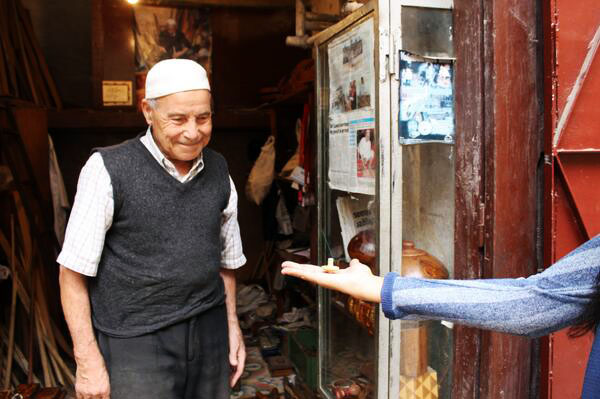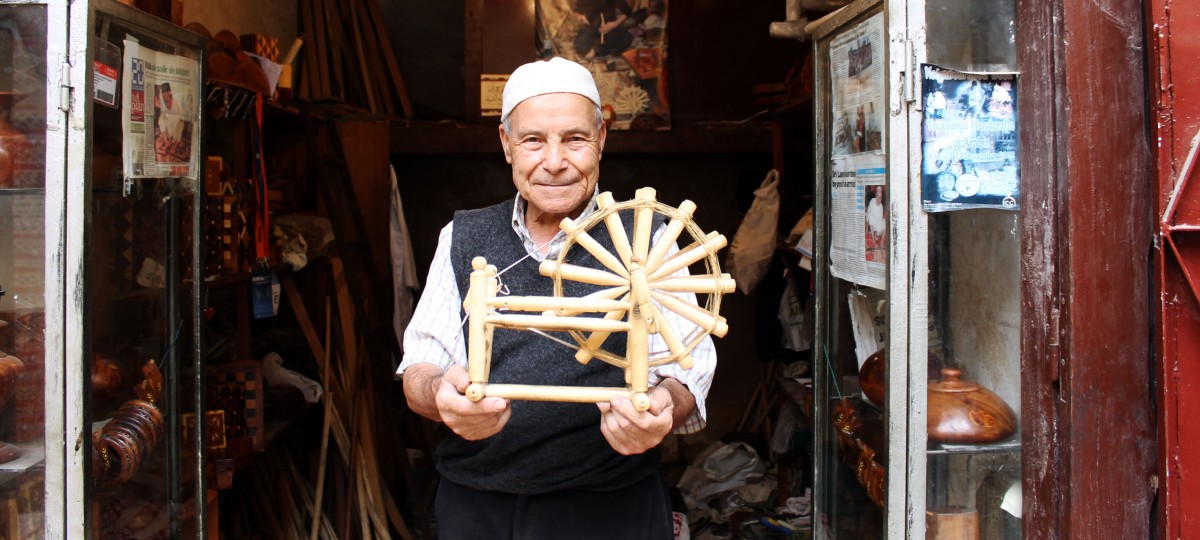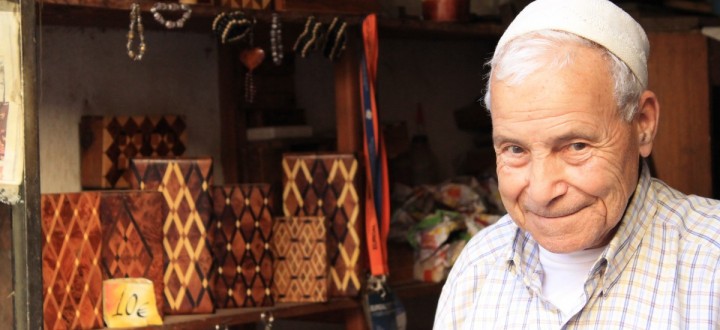Wandering through the old Fez Medina, where vendors of various goods peddle their wares, an older woodworker stands apart from the rest. In the middle of the hustle and bustle (emphasis on hustle), I notice him, an old man bent over his crafts. Beautiful wood pieces that he has carved by hand are stacked up and spread out in front of his stall. Surrounded by an incredible array of colorful crafts—leather goods, glassware, mosaic dishware, beautifully woven rugs, and tapestries—accented with pink, green, purple, and yellow, this man’s goods are all varying shades of brown. It was this contrast that first lured me in to take a better look.
As I walk closer, I see inside of his roughly 50 square-foot stall, shelves displaying more of his work and pricing signs—ten Euros for this, five Euros for that. Virtually unheard of, set prices are a true rarity in the Fez Medina, the land where haggling reigns. He is sitting on a foot stool a few inches off the ground. He is hunched over and using his bare feet to operate a simple machine that is carving a piece of wood in his hands.

As is the etiquette in Morocco, I ask him in French if I may take his photograph. He keeps his head down and his eyes locked on his work. I ask again, slightly louder, and then again, to where I’m nearly shouting. He looks up mildly startled, as if he’s just noticed I’m there, and I repeat myself one more time.
“May I take a photo of you?”
He smiles a shy smile, nods, and resumes his carving. He stands up shortly thereafter, comes over to where I’m standing with my roommate and instructs her to hold out her hand, palm up. With a flick of his fingers, there is a wooden top spinning on her hand, as he stands back and smiles proudly. We are both little girls again, laughing with delight at the simple little toy he has just created.
Meet Mohammed Belmajdoub, an older man, so soft-spoken, I have to lean in to hear him over the chaos of the medina; Mohammed starts talking about his craft. The toy top is made of cedar wood, he tells us. He holds it up to each of our noses in turn so we can inhale the scent. He bends down and picks up a checkerboard box that opens to reveal a backgammon board inside and nearly a hundred little intricately hand-carved wooden pieces for playing chess or backgammon. Impressed by what I see, I ask him how long it took him to complete. “This took me one whole day,” he says with a tone that hints that he thinks that’s too long to complete something so simple by his standards.
I ask Mohammed to tell me more about himself as he shows us his other creations. His father was a woodworker, as was his father before him. I try to learn more about the timeline, but he murmurs “1935” multiple times as the answer to different questions. Whether that’s the year his father purchased the stall in the medina, the year in which Mohammed was born, or both, is still not quite clear. I get the feeling that the passage of time is rather unimportant to him, something that is consistent with what I know of Moroccan culture. In a place where hard facts are hard to come by (depending on which local you ask, the medina’s population can be anywhere from 100,000 to 300,000 and the number of mosques are reported to be between 110 to 400), I’ve learned to be content with approximations. He grabs a box with a beautiful pattern and pointing with his finger, identifies the different types of wood used in creating this piece: “cedar, citron, mahogany.” He opens the box, holds it up to his nose, closes his eyes, and inhales. He looks content and peaceful. He opens his eyes and, wanting to share the gift of woody scent, holds it up to my roommate’s nose and then to mine. The aroma is quite pleasant, though I know my appreciation for it doesn’t come close to his.
Mohammed himself has been a woodworker for 60 years. He says he has been invited to participate in various shows around Europe to demonstrate his craft; his work has allowed him to see the world. In Morocco, there has been a strong movement to preserve local artisanal talents and, by extension, cultural heritage, especially in Fez. He picks up another smaller box with polished sides and hands it to me. I slide open the top and a little wooden snake springs up at my hand, which makes me jump, much to everyone’s amusement.

I have returned to Mohammed’s stall to visit him a few more times since our first meeting. I’ve watched him perform his spinning top trick with many potential customers who stop to peruse his work, and each time his performance is met with smiles and laughter. Even if they don’t buy anything, people invariably leave Mohammed’s stall smiling and a little more light-hearted than when they arrived. I can’t help but smile, too.
Mohammed has six grown children who all have children of their own. Not a single one of his children has shown an interest in woodcarving, least of all as a vocation. They have pursued more lucrative careers like academia or accounting (a typical artisan in the Fez Medina earns anywhere from US$730 to US$1,400 annually). Most of his children no longer live in Morocco, having emigrated to France years ago. “Besides,” Mohammed shrugs, “most of this can be done with machines nowadays.” He displays a quiet stoicism when he talks about this dying art that he has dedicated the past 60 years of his life to—but I wonder if it doesn’t break his heart a little that his family’s woodworking legacy will end with him.
Increasingly, Moroccan youth are choosing to forego traditional vocational arts in favor of more financially rewarding work. This trend triggered the Moroccan government to establish a couple of artisanal schools to preserve the heritage of these crafts. One of them, L’Institut des arts traditionnels de Fes, boasts 500 male and female students ranging from 16 to 30 years of age learning 40 some-odd arts. In addition to handiwork, it also offers introductory business education as well as micro-financing. The goal of the school is to preserve the “millennia-old tradition while adapting to a modern economy.” While the school has been successful enough to warrant new programs in other major artisanal hubs like Marrakech, few students, if any, have the desire to take their developed skill sets into the medina. It’s hard to imagine the medina without these artisans because the Fez Medina has been this way for so long, but the future of the medieval walled cities with respect to the artisans within is unknown.

Mohammed gives the impression that he’s more interested in showing his handiwork and explaining his craft than he is in talking about himself or even selling his wares. He picks up a miniature spinning wheel and holds it. He’s really proud of this particular piece. In his stall, he has articles with pictures featuring himself with this creation. He gestures at my camera and poses. I obligingly take a picture. “How much?” I ask out of curiosity, pointing to his most prized piece of work. He smiles. “This one is not for sale,” he says. “This piece is just for me.”
Jeni Wang
Jeni Wang is an MBAs Without Borders Advisor in Morocco working as an Enterprise Development Specialist. Jeni graduated from New York University with a degree in French and History and a minor in Spanish. Jeni attended UCLA Anderson earning an MBA in Marketing and Brand Management and discovering the belief that doing well and doing good are not two mutually exclusive achievements.






Special thanks to Jess Stephens, a Welsh expat living in Morocco, who was kind enough to sit down with me to provide the information on the Fez Medina artisans and an artisanal school that is otherwise not readily available. An artist herself, she is fascinated with the legacy of the Fez Medina artisans and started facilitating small half day or full day tours to souks in the Medina to get a behind-the-scenes glimpse into the artistry involved, and all of them end at a Fez artisanal school (Le Centre de Formation et de Qualification dans les Métiers de l’Artisanat). The point of the tours is to talk with the local artisans and hear their story without the typical sales pressure. This relaxed atmosphere provides a much more open and arguably pleasurable experience in learning about these millennia-old practices and the people who continue the legacy. In addition to being able to traverse the pigeon and pigment pits in the tanneries on the ground, those who are interested can also try their hand at a variety of Fassi (from Fez) handicrafts from metal working to Zellij (Moroccan tile mosaics). Find out more about Jess and her group, Culture Vultures, here: http://culturevulturesfez.org/
Pingback: Artisans Of Morocco